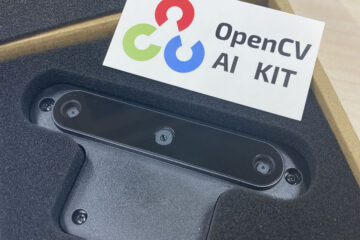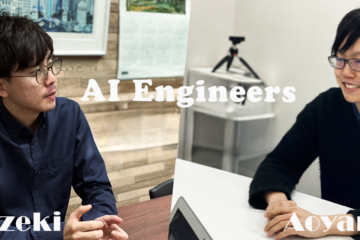
Have you ever been curious about the inner workings of VP-Motion? This groundbreaking system transforms the the way we understand and detect human behaviors.
If you’re a bit puzzled, you’re not alone. VP-Motion stands at the forefront of innovation, fundamentally altering our comprehension and analysis of human behavior. Essentially, VP-Motion uses artificial intelligence (AI) as its core to learn and detect human behavior through skeleton information.
In our previous blog, we highlighted why VP-Motion stands out as a game changer. This time, we’ll take you behind the scenes, unraveling the mystery of its functionality. By the end of this read, we aim to provide you with a clear understanding of how VP-Motion operates and the potential benefits it brings.
For more insights, don’t miss our latest blog post: VP-Motion: What Makes It a Game-Changer? – NEXT-SYSTEM BLOG👈
But first, let’s start by examining the system components of VP-Motion.
System components of VP-Motion
VP-Motion, a dynamic system, comprises two fundamental elements: the Training part and the Detection part. Within this comprehensive structure, the system seamlessly integrates three essential applications: the ‘VP-Motion Annotator‘ for creating teacher data, the ‘VP-Motion Trainer‘ as the learning system, and the ‘VP-Motion Monitor‘ for real-time surveillance.
This meticulously designed framework allows these three applications to collaborate effortlessly, facilitating the creation of trained AI models through machine learning. By simply inputting video data, these models proficiently monitor a range of video images, whether from prerecorded videos or live feeds.
Now, take a closer look at the details of this organized system.
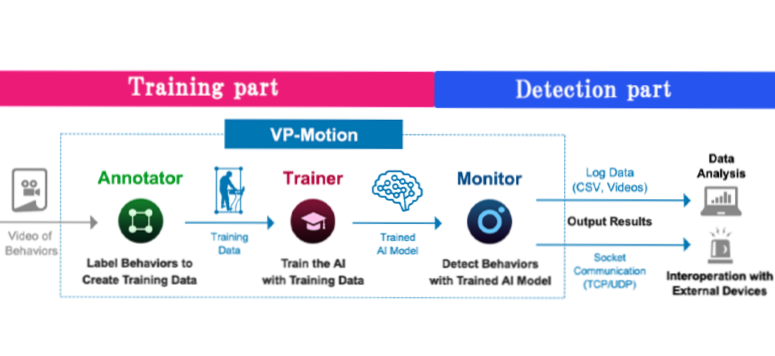
How the system works?
Training Part
The Training part plays a crucial role in training the system about different human behaviors. It involves two essential applications: Annotator and Trainer.
VP-Motion Annotator
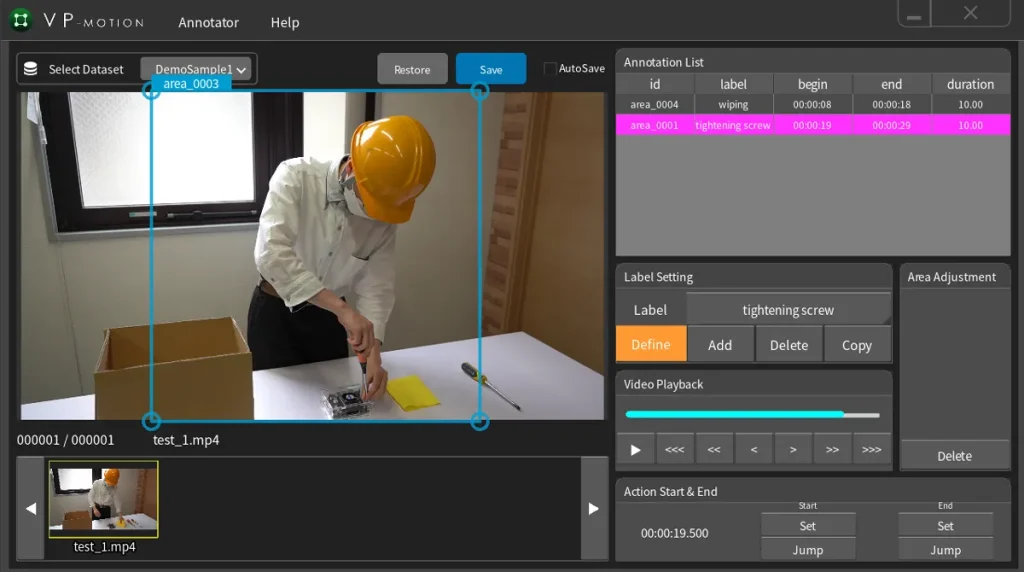
This application is a vital tool for creating training data, where real-world video footage or motion capture data is annotated with the specific observed behaviors. This process is essential for creating high-quality training data, which is then used to train the AI in the VP-Motion Trainer.
Here’s how it works: after collecting videos that showcase the desired behaviors, import them into the annotator, label with the behaviors for detection and create the training data. To label the behavior, simply draw a square around the action and assign it a name. This way, the tool creates a kind of ‘Training data’ that helps VP-Motion get better at understanding and predicting those actions. With it’s user-friendly interface, the tool is accessible even for those who are not a tech expert, allowing for efficient preparation of training data.
VP-Motion Trainer
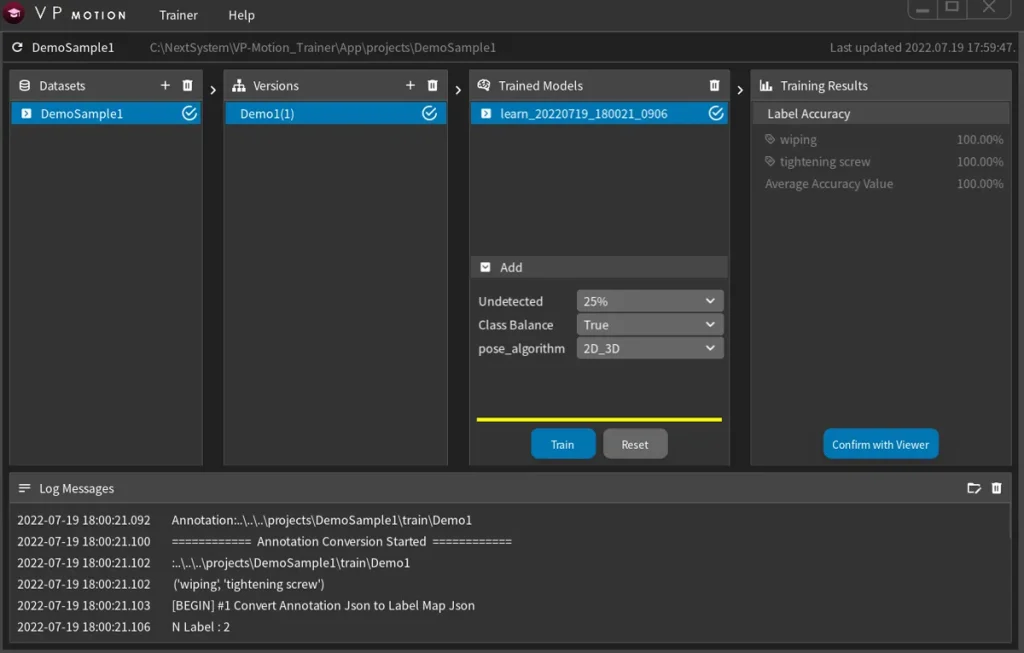
This application utilizes Training Data to train AI capable of identifying and classifying human behaviors.
Starting with the training data created in Annotator, the next step involves constructing a trained model in Trainer. The resulting trained model is utilized in monitoring system, known as ‘VP-Motion Monitor’. A noteworthy feature is the system’s ability to aggregate training data created by multiple individuals, streamlining the process into a singular trained model for operational efficiency.
The speed of the learning process is influenced by factors such as the resolution and frame count of the loaded videos, as well as the specifications of the operating PC. Generally, the training can be completed within a matter of seconds to a few minutes for each video, showcasing the flexibility and efficiency of the overall training procedure.
Detection Part
Once the training phase is complete, the Detection part comes into play.
VP-Motion Monitor
This application integrates with the trained models created in VP-Motion Trainer to analyze both real-time footages or prerecorded videos. Additionally, it suppports monitoring on up to eight cameras simultaneously.
Now, let’s delve into practical applications. By utilizing the trained model created in Trainer, you can establish a monitoring system capable of detecting the ‘Desired behaviors.’ This system not only function as surveillance cameras with behavior detection logs but also as recording software. It facilitates real-time monitoring with both live footage and prerecorded videos, offering a dual approach to behavior analysis: Skeleton-Based and Image-Based. This versatility makes it a comprehensive tool for in-depth behavior analysis.
Skeleton-Based Analysis

Skeleton based analysis is based on human skeletal information. This method excels when there are numerous characteristics to detect in movement and actions. It can accurately identify these characteristics, even when only the upper body is visible or when multiple people overlap.
What sets this approach apart is its remarkable ability to detect actions accurately with surprisingly short learning periods. Imagine the efficiency gains—routine tasks and human movements become seamlessly checked. The system proves invaluable in preventing oversights, enhancing workplace safety by minimizing accidents, and monitoring nuanced tasks that might otherwise go unnoticed. As a result, all these factors contribute to a significant enhancement in overall work efficiency.
Image-Based Analysis

In the world of behavior analysis, Image-Based Analysis involves analyzing surroundings such as background, objects, and colors and beyond. It goes beyond mere person detection, extending its reach to capture image information around the human body, including tools in hand and task-related devices. This method proves particularly effective for analyzing scenarios with limited skeletal movement features, such as intricate hand movements when handling tools.
VP-Motion offers a versatile and powerful solution for behavior detection and analysis. Its modular design, integrating both Skeleton-based and Image-based analysis, enables precise monitoring in various scenarios.
The system’s adaptability and ease of customization, facilitated by simple packet communication, make it well-suited for environments with diverse needs. Whether it’s real-time monitoring, behavior analysis, or triggering alerts based on specific actions, VP-Motion’s capabilities contribute to enhancing efficiency, preventing oversights, and ensuring a comprehensive approach to video-based analytics. With features such as the ability to monitor and record video from multiple cameras and flexible socket communication options, VP-Motion stands out as a robust tool for tailored and effective behavior detection systems.
👉Stay tuned as we explore deeper into the transformative potential of VP-Motion in our upcoming blog posts!
▼ Check one of the real-time examples of behavior detection in action with our system, ‘VP-Motion’!
If you require additional information, please do not hesitate to reach out to us.

